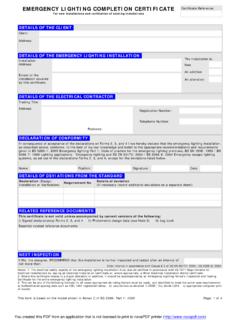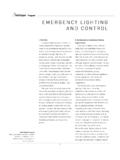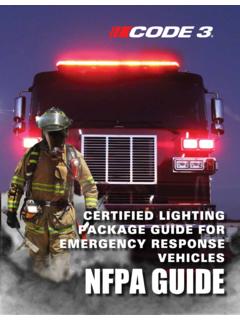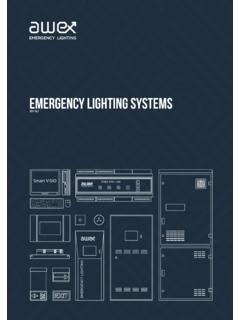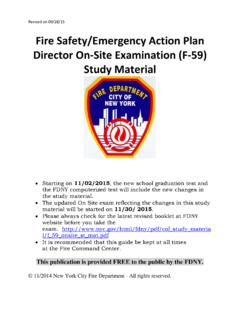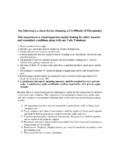Transcription of NOTICE OF PUBLIC HEARING - City of New York
1 Page 1 of 4 Department of Environmental Protection Promulgation of Amendments to Title 15 of the Rules of the City of New York Rules Concerning the Registration of emergency Generators NOTICE IS HEREBY GIVEN PURSUANT TO THE AUTHORITY VESTED IN THE Commissioner of Environmental Protection by Sections 1043 and 1403(b) of the Charter of the City of New York and Sections 24-105 and 24-109 of the Administrative Code of the City of New York, that the Department of Environmental Protection promulgates a rule concerning the registration of emergency generators. These amendments were proposed and published on January 23, 2012 in the City Record. The required HEARING was held on February 22, 2012. Rule Amendment Pursuant to the authority vested in the Commissioner of Environmental Protection by Sections 1043 and 1403(b) of the Charter of the City of New York and Sections 24-105 and 24-109 of the Administrative Code of the City of New York, the Department of Environmental Protection promulgates a rule concerning the registration of emergency generators.
2 The rule was listed in the Department s fiscal year 2012 Regulatory Agenda. Statement of Basis and Purpose The main purpose of the rule is to: 1) Provide for streamlined regulation of emergency generators reflecting their limited use, by requiring registration instead of a certificate of operation. 2) To ensure that emergency generators are used only for emergency situations, and 3) To control the emission of harmful air contaminants by emergency generators. The rule accomplishes these purposes by: Clarifying the registration requirements for emergency generators in lieu of a certificate of operation, Adopting a definition for emergency generators, based on State regulations, which limits the size and power of emergency generators, and the number of hours that they can be used, Requiring tracking of the hours of operation for registered emergency generators, and Requiring smoke tests for emergency generators. The rule will ensure that DEP knows how many emergency generators exist, how often they are being used, and that they are being operated solely for testing and to address emergency situations.
3 Background Page 2 of 4 Section 24-105 of the Administrative Code authorizes the Commissioner to take action to control the emission of air contaminants and to adopt rules to accomplish the purposes of the Air Pollution Code. DEP is responsible for regulating and permitting the use of equipment that emits air pollutants, such as emergency generators. Section 24-109(b)(3) provides that emergency generators, as fuel burning equipment, must be registered with DEP. Definition of emergency Generators The New York State Department of Environmental Conservation has adopted regulations that define certain generators as emergency generators, and exempt such generators from certain emissions limits and permitting requirements. DEP has reviewed these State regulations and has decided to adopt the State definition, with certain changes, in the rule. The definition establishes that emergency generators: Are internal combustion engines sized 350,000 btu/hr and greater, or 138 hp or greater, Are permanently connected to the electrical system of a building, Operate only when the usual supply of power is unavailable (not for peak shaving), and Operate for no more than 500 hours per year.
4 This definition differs from the State definition in the following ways: 1) The State definition includes a reference to the generator being stationary, while the definition in the rule provides that the generator must be permanently connected to the electrical system of the building, which is more specific and precise. 2) The definition in the rule includes a size limitation, because DEP does not regulate smaller fuel burning equipment. 3) The State definition specifies that an internal combustion engine used for peak shaving is not an emergency generator. DEP is clarifying that emergency use, as defined elsewhere in the State regulations, could render the internal combustion engine an emergency generator. Certificate of Operation Not Required Most generators, including those which are used for peak shaving generation or as temporary power sources, require a certificate of operation under section 24-122 of the Administrative Code. The rule clarifies that those generators that meet the definition of emergency generator do not require a certificate of operation due to their limited use.
5 Registration and Testing of emergency Generators The rule establishes that emergency generators must be registered. To be registered, emergency generators must: Pass a smoke test, and Have their hours of operation recorded and documented by the owner or operator. A stack test certified by a professional engineer or registered architect may be performed on the emergency generator in lieu of a smoke test, which is to be performed by a qualified observer (as defined in federal regulations). Page 3 of 4 Shall and must denote mandatory requirements and may be used interchangeably in the rules of this department, unless otherwise specified or unless the context clearly indicates otherwise. ** Title 15 of the Rules of the City of New York is amended by adding a new Chapter 40 to read as follows: Chapter 40 Rules Concerning the Registration of emergency Generators 40-01 Definitions Department means the New York City Department of Environmental Protection.
6 emergency generator means an internal combustion engine that: (a) is sized 350,000 btu/hr and greater or 138 hp or greater, (b) is permanently connected to the electrical system of a building, (c) operates as a mechanical or electrical power source only when the usual supply of power is unavailable, and (d) operates for no more than 500 hours per year. The 500 hours of annual operation for the engine include operation during emergency situations, routine maintenance, and routine exercising (for example, test firing the engine for one hour a week to ensure reliability). An internal combustion engine used for peak shaving generation is not an emergency generator; however when used for a natural, accidental, or intentional human-caused event or circumstance which presents an immediate threat to life, health, property, general welfare or natural resources, such engine is an emergency generator if it otherwise meets this definition. Peak shaving generation means the practice of utilizing on-site generating capacity for use at a facility (excluding emergency generation when the usual sources of heat, power, and lighting are temporarily unavailable) at the request of the primary electricity supplier.
7 Qualified observer means a qualified observer in accordance with Test Method 9 (40 Part 60, Appendix A-4). 40-02 Filing and Recordkeeping Requirements. (a) The owner of an emergency generator must register the emergency generator in accordance with section 24-109 of the Administrative Code. An emergency generator must pass a smoke test conducted by a qualified observer in accordance with Test Method 9 (40 Part 60, Appendix A-4). A stack test may be performed, instead of a smoke test, in accordance with 15 RCNY 2-08 and must be certified by a professional engineer or a registered architect. Proof of the smoke test or stack test must be submitted to the Department with the registration. Page 4 of 4 (b) The owner or operator of an emergency generator must maintain records documenting hours of operation. Such records must be maintained for five years and must be made readily available to the Department upon request.











